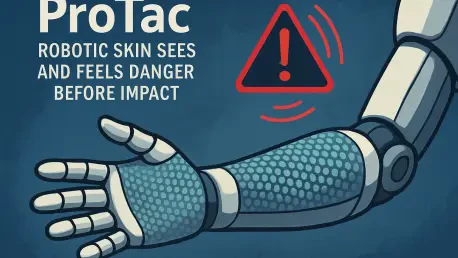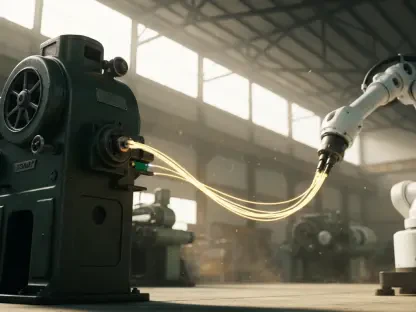What happens when a robot in a bustling factory can’t sense a worker stepping too close, or when a caregiving machine fails to adjust its touch for a fragile patient? Every year, thousands of workplace accidents involving robots highlight the urgent need for smarter, safer machines. Enter ProTac, a groundbreaking robotic skin developed by researchers at the Japan Advanced Institute of Science and Technology (JAIST), designed to let robots “see” approaching threats and “feel” contact before disaster strikes. This isn’t just about preventing collisions; it’s about redefining how robots coexist with humans in dynamic, unpredictable environments.
A Game-Changer in Robotic Perception
The significance of ProTac lies in its ability to bridge a critical gap in robotics: real-time awareness over large areas. Traditional sensors often struggle with dynamic settings, leaving robots blind to sudden changes or unable to respond with precision. This innovative technology, however, equips machines with a soft, vision-based skin that anticipates danger and reacts instantly, promising a new era of safety and collaboration between humans and robots across industries.
At the heart of this breakthrough is the potential to transform everyday interactions. From assembly lines to hospital wards, the demand for robots that can navigate complex spaces without causing harm has never been higher. ProTac offers a solution that doesn’t just react to contact but predicts it, ensuring that machines become intuitive partners rather than potential hazards in shared spaces.
The Mechanics Behind the Magic
ProTac’s ingenuity stems from its dual-mode sensing system, embedded in a soft layer of polymer-dispersed liquid crystal (PDLC). When transparent, built-in cameras detect nearby objects, enabling robots to gauge proximity and adjust their actions accordingly. When switched to opaque, those same cameras capture skin deformations to analyze touch, pressure, and exact contact points with remarkable accuracy.
This seamless integration of vision and tactile feedback sets ProTac apart from conventional electronic skins, which often require complex hardware for limited results. A prototype known as the ProTac link—a cylindrical robot arm segment equipped with stereo cameras—demonstrates this precision, successfully identifying objects from various angles and estimating distances in real time. Such capabilities hint at a future where robots handle tasks with a finesse previously thought impossible.
Beyond technical feats, the simplicity of the design ensures scalability. Without the burden of intricate wiring or dense sensor arrays, this technology can be adapted to diverse robotic platforms, making it a practical choice for industries seeking efficient upgrades. The focus on streamlined functionality reflects a broader trend in robotics toward smarter, less cumbersome systems.
Real-World Impact Across Industries
Picture a factory floor where robots slow down as workers approach, preventing accidents before they happen. ProTac makes this a reality by enabling machines to detect human presence and adjust speed or trajectory instantly. In industrial settings, where safety incidents remain a concern, such responsiveness could drastically reduce risks and boost productivity.
In healthcare, the implications are equally profound. Service robots equipped with this skin can assist patients or the elderly with a gentle touch, sensing pressure to avoid injury while providing support. This adaptability opens doors to applications in elder care, where robots must balance strength with sensitivity to meet individual needs.
Even fields like agriculture stand to benefit. Robots handling delicate crops or navigating uneven terrain could use ProTac to adjust their grip or avoid obstacles, ensuring efficiency without damage. These varied use cases underscore the versatility of the technology, positioning it as a cornerstone for safer, more capable robotic systems in countless environments.
Expert Perspectives on a Revolutionary Step
Professor Van Anh Ho, a lead researcher at JAIST, captures the essence of this innovation with clarity: “The aim is to surpass the constraints of traditional electronic skins by delivering real-time sensing over expansive areas without complicated setups.” This vision reflects a drive to simplify while enhancing robotic potential, a balance that could redefine industry standards.
Dr. Quan Khanh Luu, another key figure in the project, envisions broader horizons, noting, “This marks a foundation for full-body sensing in humanoid robots, replicating the subtle awareness of human skin.” Such ambition points to a future where robots don’t just mimic actions but embody a deeper understanding of their surroundings.
The commitment to progress doesn’t stop with development. By sharing design files and software as open-source resources, the team invites global collaboration to refine and expand ProTac’s reach. This openness signals a collective push toward advancing robotics, ensuring that innovation benefits a wider community of developers and industries.
Bringing ProTac to Life in Practical Settings
Integrating ProTac into existing systems starts with assessing compatibility. Its modular design allows for retrofitting on current robotic platforms or incorporation into new builds, offering flexibility for various applications. Industries can evaluate their needs—whether for safety in factories or precision in medical settings—to tailor the technology effectively.
Leveraging the open-source materials provided by the JAIST team accelerates adoption. Developers can access detailed models and software to customize the skin for specific tasks, from enhancing collision avoidance in warehouses to enabling delicate interactions in domestic care. This accessibility lowers barriers, fostering rapid implementation across sectors.
Testing in real-world scenarios remains crucial. Pilot projects, such as outfitting a manufacturing robot to monitor human proximity, provide insights into performance and reliability. Combining these trials with learning algorithms developed alongside ProTac ensures that sensor data translates into adaptive behaviors, paving the way for scalable, impactful deployment.
Reflecting on a Milestone in Robotics
Looking back, ProTac stood as a defining achievement in robotic sensing, blending vision and touch into a single, soft layer that transformed how machines interacted with the world. Its ability to anticipate danger and respond with precision marked a turning point for safety in human-robot collaboration. As industries adopted this technology, the groundwork was laid for even greater strides. Moving forward, the focus shifts to refining durability and addressing scalability costs through continued global partnerships. Exploring full-body sensing for humanoid robots emerges as the next frontier, promising machines that not only coexist but truly understand the nuances of human environments.









